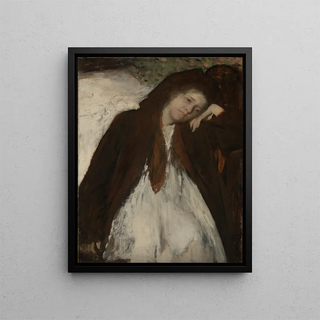Art print | The convalescent - Edgar Degas


View from behind

Frame (optional)
In the vast panorama of Impressionism, Edgar Degas's artwork "The Convalescent" stands out for its delicacy and psychological depth. This canvas, which bears witness to a period of reflection and transition, invites the viewer to delve into the intimacy of a moment of rest and recovery. The scene, imbued with tenderness, evokes the fragility of the human condition while celebrating the beauty of everyday life. Through this art print, one can appreciate how Degas captures a fleeting reality, transforming a simple instant into a timeless masterpiece.
Style and uniqueness of the artwork
Edgar Degas's style is characterized by a unique approach to movement and light. In "The Convalescent," he employs a subtle palette that oscillates between soft tones and delicate shadows, creating an atmosphere that is both soothing and introspective. The composition, focused on the main character, is skillfully balanced by surrounding elements that reinforce the notions of solitude and recovery. Degas, faithful to his penchant for realism, does not seek to embellish the scene but rather to reveal its raw truth, offering an authentic vision of the human experience. The posture of the convalescent, both vulnerable and serene, demonstrates a deep sensitivity, giving this work a rare emotional dimension.
The artist and his influence
Edgar Degas, an emblematic figure of Impressionism, transcended the conventions of his time to offer an unprecedented vision of modern life. His fascination with movement, whether human or animal, manifests through a multitude of subjects, ranging from ballet to scenes of daily life. In "The Convalescent," he demonstrates exceptional mastery of body representation, while incorporating compositional elements that reflect his interest in perspective and space. Degas's influence extends far beyond his era, inspiring generations of artists to explore the dynamics of movement and the psychology of characters. His ability to capture the essence of the moment, while maintaining an analytical approach, makes him a pioneer.

Matte finish

View from behind

Frame (optional)
In the vast panorama of Impressionism, Edgar Degas's artwork "The Convalescent" stands out for its delicacy and psychological depth. This canvas, which bears witness to a period of reflection and transition, invites the viewer to delve into the intimacy of a moment of rest and recovery. The scene, imbued with tenderness, evokes the fragility of the human condition while celebrating the beauty of everyday life. Through this art print, one can appreciate how Degas captures a fleeting reality, transforming a simple instant into a timeless masterpiece.
Style and uniqueness of the artwork
Edgar Degas's style is characterized by a unique approach to movement and light. In "The Convalescent," he employs a subtle palette that oscillates between soft tones and delicate shadows, creating an atmosphere that is both soothing and introspective. The composition, focused on the main character, is skillfully balanced by surrounding elements that reinforce the notions of solitude and recovery. Degas, faithful to his penchant for realism, does not seek to embellish the scene but rather to reveal its raw truth, offering an authentic vision of the human experience. The posture of the convalescent, both vulnerable and serene, demonstrates a deep sensitivity, giving this work a rare emotional dimension.
The artist and his influence
Edgar Degas, an emblematic figure of Impressionism, transcended the conventions of his time to offer an unprecedented vision of modern life. His fascination with movement, whether human or animal, manifests through a multitude of subjects, ranging from ballet to scenes of daily life. In "The Convalescent," he demonstrates exceptional mastery of body representation, while incorporating compositional elements that reflect his interest in perspective and space. Degas's influence extends far beyond his era, inspiring generations of artists to explore the dynamics of movement and the psychology of characters. His ability to capture the essence of the moment, while maintaining an analytical approach, makes him a pioneer.






